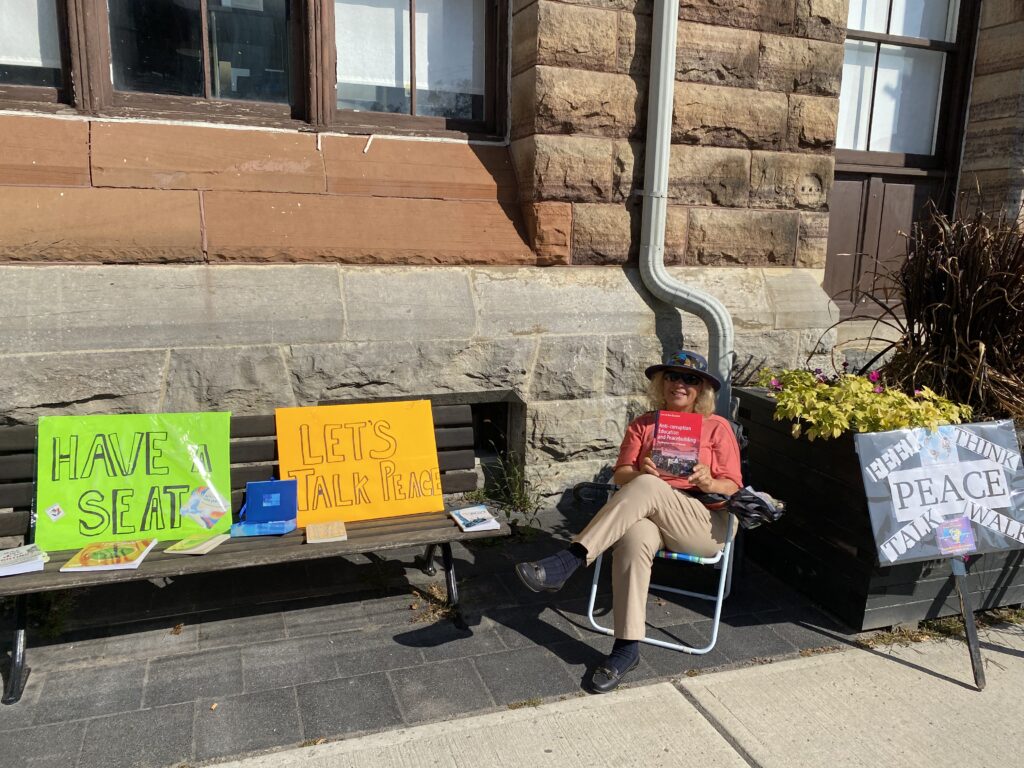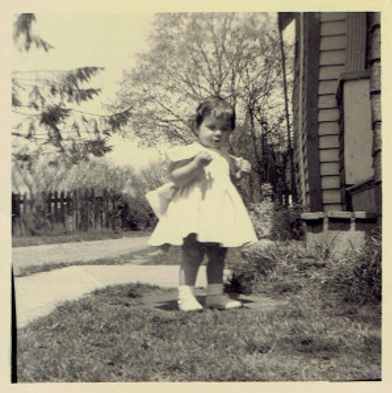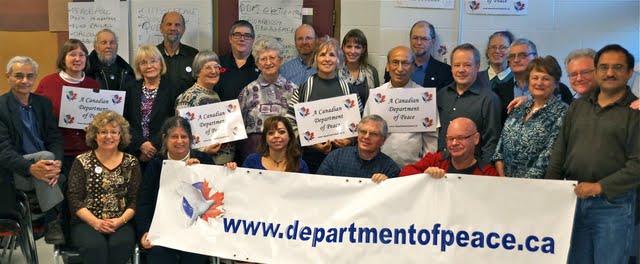
My anxiety over the growing international conflicts led me to respond to many of the online conferences by peacebuilding professionals. The International Peace Bureau, Germany hosted an international conference on June 10 and 11th 2023. The results of that compelling forum were a Final Declaration calling for a Ceasefire and Negotiations in the Ukraine/Russian war and a call to all citizens to show support for this between September 30- October 8. My contribution was to hold a 9-day street vigil to let people know there are peaceful means to resolve the conflicts violent or not that are occurring today. During my 9-day vigil, I was asked several times what brought me to this work and this position. I don’t think about that often but I do think it is miraculous that I stand for peace at this point in life
My Beginnings

I was the third child born to a family who had come to Canada from war-torn Malta in 1948. They had challenges. My parents worked very hard. My father worked shift work at a local factory and repaired and renovated our older home. My mother was hospitalized soon after her arrival in Canada and spent 6 months in traction. When she recovered she worked endless hours as a homemaker, growing and storing food, making our clothes, cleaning, and managing the finances. As I started to see the world
beyond the joyous self-centredness of a toddler things were not so idyllic. My parents were discontent with their home because it needed constant repair that my father loyally attended to as well as renovating it to accommodate our growing family that now included my younger brother.
I started school at the age of six and was surprised to find out life did not flow the way I had been used to. The children didn’t befriend me. I was different. I did not realize that at the time until one day, my mother came into the classroom to take me to get shoes and the class laughed at her accent.
I was also greatly disturbed when we moved and I had to leave my school and my magical (to me) home and natural surroundings. We moved to a new subdivision that was void of trees and natural life in general. Our household changed. My parents were more anxious, and critical and every morning was a chaos of arguing. At school, I was regularly reprimanded for speaking to other children in class or strapped for laughing as my imagination would take the teacher’s stories to a hilarious daydream.
By grade 2 I was beginning to notice none of the kids seemed to like me nor the adults. I was reprimanded by my teacher because I didn’t do my art as she expected and the priest expressed disdain when asked what I truly would like to have in heaven and I answered my favourite meal, spaghetti. One little girl attracted me. She was sweet, kind, and likable. My way of engaging her was to twist her arm behind her back to make her like me. Clearly, I was limited in social skills. I was sent to the Principal’s office to a nun whose name I cannot recall but she was the light that shone compassion on my frustration and loneliness. She listened to what happened. She posed another possibility on how to make friends. I wanted to be in her space forever. She sent me on my way with a new awareness of what it meant and felt like to be kind, to feel kindness. I felt a calm that I have rarely experienced in myself.
Life did not go smoothly after that but there was a seed of a new understanding. I was also deeply confused as I experienced and was conscious of many inconsistencies in the teachings about Love and caring for others while interactions by adults in particular were hurtful. There was the constant angst between my parents that bled over us their children. The discrimination at school that I experienced between how boys were treated compared to girls or the children from less privileged conditions to those with fine clothes and the social norms to stay out of trouble. I became more belligerent and challenging in response to what I felt was unfair. I was in trouble a lot. Yet, this was the beginning of my lifelong search to find ways to face conflicts based on differences and power with a better ending than what I was witnessing.
I managed through school to pass but I was not a star student. I started to make friends and learned a lot about what makes people tick. I listened to my parents recounting of what it was like to live through WWII. Large sections of Malta were destroyed through a bombing blitz considered to be worse than the one in England. My father reported finding body parts when he, out of curiosity, would comb the streets to see what happened for himself. My mother recounted the constant sense of dread and the terror of being carried to a bomb shelter during an attack when she was in labour with my first sister. Malta was on the good guys’ side. What happens if you are one of the bad guys?
Learning to Love Who I Truly Am
After high school, I hitchhiked on my own throughout Europe. I loved the wonder of these new places. The ability to communicate without a common language. To my surprise, not every man was sexually programmed to accost me as I had been taught by home and church. There were some pretty sleazy characters but rare and nothing compared to the men and women who met me and helped me be safe and stay healthy for no other reason than we were human beings. This truth that most people are kind and helpful has been my reality through a lifetime of travel that included Western and Eastern Europe, Africa, and Central and South America.
In my travels, I noticed two things: extreme pollution and armed soldiers walking the streets of many cities. Both were disconcerting. Canada’s environment in the ’60s was pristine. No matter where I went in Canada I had never seen this kind of military security. Times have unfortunately changed as Canada faces serious issues of pollution and national security.
I came back from my initial travels clear that I wanted to be in Canada close to family and to start a family. I married in 1974 and had 4 children. Yet, there was this thread of anger and desperation that regularly appeared in my life. I often brought these emotions to my husband challenging him for not making me happy. I looked to my faith to help me be happy in my marriage. I found it lacking as well to offer me a model of spirituality lived in a life filled with diversity and challenge.
I believe the answer to my prayer was my son whose behaviour was over the top. Extreme emotional responses resulted in his being placed in a psychiatric ward at the age of 6 and being in the corrections system off and on until he was 14. His father and I had to look far and wide to get the help that wasn’t based on the belief “ he is a bad seed” or “he is your cross to bear”. In reality, he was an intelligent, insightful boy who needed help to manage his hyper responses to things in his life. Yet, we were assumed to be the cause of his behaviours and left to research appropriate services for him. These experiences taught me to not blame and judge people who are struggling. I have found that people are doing their best with what knowledge and skills they have. Starting from that mindful place lets people and myself open to creative inquiry and enables people to make their own lives better.
Learning to Love Others
Learning how to love myself was essential to facing conflict without judgment, blame, and humiliation. I learned that the degree I love and accept my humanity is the degree to which I can love and accept the reality of others.
My ability to have relationships with others was still limited as it had been in my earlier years. During these rich years meeting other Moms and people looking for how to live peace I learned how to have friends. Those people who see you for who you are, the bright light and the dark edges and they love you through thick or thin.
I obtained two degrees in psychology that resulted in me finding a noncompetitive process of learning and social action-based research. These studies focused on understanding healthy social environments and how to design interventions to support those facing personal, organizational, or political discord. My first professional job was as a psychometrist at a local hospital Psychiatric Ward. My second degree moved away from the medical model of health care. It was from Wilfrid Laurier University, Community Psychology that equipped me with tools to support people to do what they know they need to do in ways that reflect their cultures and personal strengths. It also introduced me to peacebuilding skills used by the Mennonite Central Committee of Eastern Canada. It was happening. I was finding ways to facilitate healing processes that did not blame, shame, or punish people who have faced personal or collective pain and dysfunctional patterns in their relationships. Of course, this provided me with more understanding of myself, my anger, and my desperation. This was the most difficult part of the journey for sure.
Then came the difficult challenge of finding somewhere to work that would support these values of inclusion, compassion, integrity, shining light on the strengths people have, and more. Seeking a place to work and express my values and principles in the field of conflict resolution and peacebuilding that had not taken root in Canada required that I build a lot of confidence in the value of peacebuilding. I was often my only advocate until I met professional peacebuilders such as Ben Hoffman, Florie Storie and Gord Breedyk.
Current Life as a Peace Professional
Not to get into a job description I will summarize the many places I found that has embraced conflict transformation based on a culture of peace. These organizations consciously bring the values and principles of peaceful approaches to conflict and face the challenges of living them.
I will list some of my sources and leave it to you to explore what it is, who leads it, and what they do. I was trained and worked for the Mennonite Church of Eastern Ontario, Concorde and Canadian International Institute of Applied Negotiation (CIIAN), Organizational Development Appreciative Inquiry (ODNOO), Circle of Care: Indigenous Family Services, Civilian Peace Service Canada, and the Canadian Peace Initiative and many more.

These organizations and approaches took me into individual lives, communities, government, and international settings. I came to see similarities in those who are ready for change. You can tell when people are serious about working to resolve challenges by the humility they demonstrate. They are open to change encouraging innovation with their peers and people outside their immediate circles. They value the people involved and have communication systems that invite different ideas and change which makes things better.
Over the years I have delved deeply in what are the root causes of conflict and the factors that make it hard to resolve. Mental health issues, trauma, inability to name and understand one’s emotions, social cultures that know only the humiliation of poverty, and the constant paralyzation of fear usually accompanied by addictions. And there is more that we will discover as we walk with people who have lived the worst of humanity and continue to learn peaceful means that do not shame, blame, or punish the wounded.
I am a good age. I have watched people faced with dignity and respect for who they are and not judged for what has happened make miraculous changes in their lives. With Good Help that is, using methods and processes known to make elements of conflict and struggle better people can change. This is not a naive view. Some people need help throughout their lives and should be provided with that. Any system that treats people as though they don’t want or can’t work towards a more peaceful life has lost touch with the humanity of those struggling.
Peace is possible for us personally, communally, and internationally.
To conclude I have been on a long and challenging ride that I am thankful I did. It proved to me that peace is possible, not euphoric, not immediate. Peace is dynamic. It takes time and struggle but it’s not destructive. The journey to living peace always starts with yourself. More to come in the next Blog Path to Peace: The Best Kept Secret



